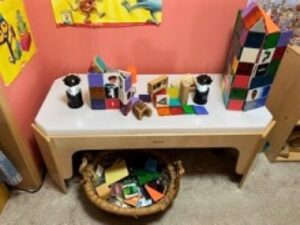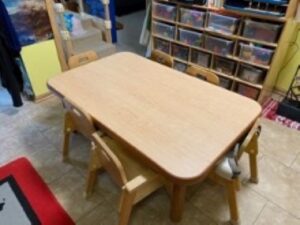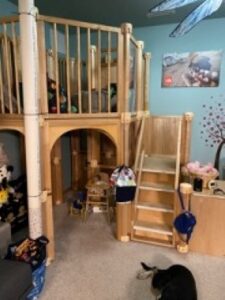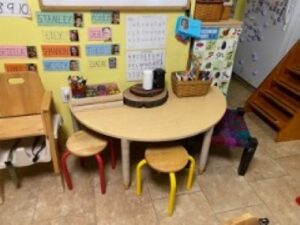Teacher Profile: Shannon
Shannon Davis
Site: Let the Dragons Fly Family Child Care
Shannon has been worked in the childcare profession for almost 24 years, starting in college then as a director. She moved to family childcare when she had children. During our conversation, Shannon shared her unique experiences as a family childcare provider working with a multiage group of eight children.

We’re trying to eliminate any plastic toxins that they might come into contact (with), and we have a lot of wood, a lot of fabrics, and [other] natural materials that we try to involve in the program.
When I’m setting up my environment, I always imagine being a little person. I try to add different levels to our environments. We have a loft that the children like to go up and explore. … We also have a quiet area where children can get away from the other kids if they need to. We have an area away from the quiet area, where there are a lot of trucks and building blocks which often gets loud, just to be respectful of the space for the children that want more of a quiet space.



[The environment] looks a little different depending on the seasons. We spend most time outside [in summer], and only come inside for sleeping, and sometimes for eating. … I make sure that space outside includes all those same things we have [indoors]. We have a literacy space outside, art space, and large motor and sensory outside. We have magnifying glasses and field guides outside. We always have writing boards and clipboards all over so they can diagram and draw what they’re exploring. Just make it super easy access for them to be able to get all the materials.

[The thing] we love the most currently is getting swimsuits on, going outside and getting wet. They just adore the water and explore the water. Even my one-year-old, I’ll make sure that I have a pool, an inch of warm water in there that they’ll enjoy. Kids are told so many times to stay out of the mud, stay out of the sand and the water, and I have the opposite philosophy like exploring the water, [exploring] what happens if you put sand in the water. I really give them the opportunity for free exploration and my group right now digs the water, and they want to be in it all the time.
I had two brothers that went on vacation with their parents to Florida last year. When they came back, they told us a story about a sea turtle that had washed up on the beach and died due to its injuries. That started a whole conversation with our group about what could have happened. We went into a project about researching sea turtles, and we watched a video of sea turtles about how they rehab, how people will help injured turtles and help them feel better. And then, children drew pictures about sea turtles and really wanted to help. So, we did a fundraiser and raised some money so that they could send it to the sea turtles in South Carolina. It was child-led, and it was an interest of theirs and they wanted to know more about it. Those are always the units or curriculum they’re the most interested in because they’re truly special to them and what they want to learn about. [The duration] of this kind of activity is child-led, I wait for them to show that they’re done with it. Once they stop asking questions, I know it’s time for us to move on and see what else we can learn about.
I think everybody’s been taking good care of each other because of their experiences with COVID over the last year, and they learned how to be empathetic and help other people. We developed a whole plan where we had a garage sale. All the families helped the children pick out things that they could bring, and we had this garage sale as a daycare. When it was over, we counted the money we raised and divided out the money to see how much we had. Then, the children picked which organization they wanted to donate to. We wrote letters and drew pictures. It was a special project that children were giving of themselves, they picked some of the things that they loved to give to somebody else. People should do when they’re young to learn how that process works, giving up [what] we love to help somebody else. It was a great lesson. In the end, we got Thank-you cards back, thanking us for that process.
“I love the beauty of developing at their own pace” – documenting and working with a multiage group
We do introduce developmental tracking and it’s called Teaching Strategies GOLD. I like that tool because it compares a child’s growth to themselves, and it doesn’t compare them to each other. We’re just looking on a continuum and we want to see progress and each of these areas for a child while they’re with me.
The reason that I love the multiage group is because children can develop at their own pace. There’s someone older and someone younger, if somebody is more advanced in a certain area, they have those peers that they can go and join in those skills, or if somebody is needing a little bit of help, they have a younger peer that they can hand with. The beauty of multiage is there’s always someone pushing you to progress, a little bit farther on you own timeline.
It’s a lifelong friendship. A lot of children grow up together for five years and those relationships carry over many years after they leave me, and these parents will stay friends for a long time. That’s a big thing, especially when they don’t have extended family around. They appreciate those friendships for not only the kids but for the adults. And I have kids come back, their parents will text me, can they come and visit. So, they remember those relationships and want to come back and check on their younger ones.
One of the challenges of family childcare obviously is the workload. It’s very common for us to work 60 hours plus per week because we’re not only teachers, but we’re also cooks, accountants, housekeepers, and cleaners. And I have a staff that I have to take care of.
And the paperwork [always drives me crazy]. For children’s files, they have to get updated, [including] their immunization records, health records, depending on the age of the child, they either have to have that every six months or every two years. Because I have a staff person, I have to keep a staff file for myself, for her, and for my husband, so that includes physical continuing education and CPR for everybody, and like traumatic brain injury prevention, child abuse and neglect prevention training. … I also have a nutritionist who visits me, so I have to record all the daily foods we eat. [I also have] my blog that I also try to do that at nap time.
My hack is to be very consistent and organized. I have a calendar that shows when everybody needs certain paperwork turned in and when everything is due, and I give parents a notice a month ahead of time that it’s due.
I was super lucky, I only closed for five weeks. And public health gave us guidance as far as how to work through COVID. Once I told the parents that I was reopening, everybody came back. They were ready and I think they felt really safe because first of all, it’s a small group; second of all, I laid out the protocol: if I’m opening again, I need all of you to commit to being safe and keeping everybody else safe. And they all were so thankful to see that we had a plan, and they could go to work at home and send their children here, knowing that they were going to be safe. We had a huge amount of trust with each other, which is a benefit of having such close relationships with each other.
Oftentimes that might look like me sitting down and playing, but I’ve been doing [this] for such a long time, so I recognize the skills that children are starting to get and how to use different toys and play-based learning to help them achieve those skills.
As far as the multiage education, when they see a younger child needing help, they’re able to help and feel the sense of accomplishment, that’s a skill that will carry over when they start school. I’m not into learning ABC and all the numbers, all the stuff that’s going to happen when they go to school. My job is more the social relationship, part of development. Teachers in the public school system just evaluate all of those academic skills, and it’s hard to take a step back when they see a child that struggling in the relational part of growth and development.

